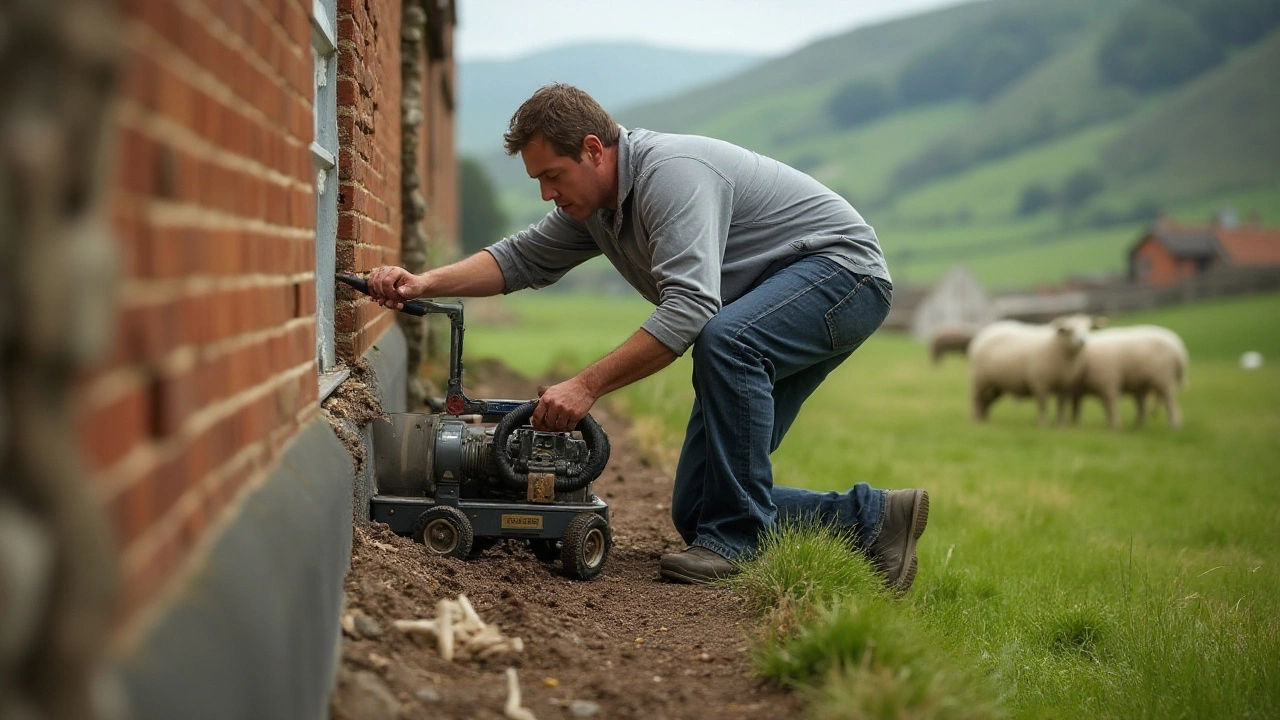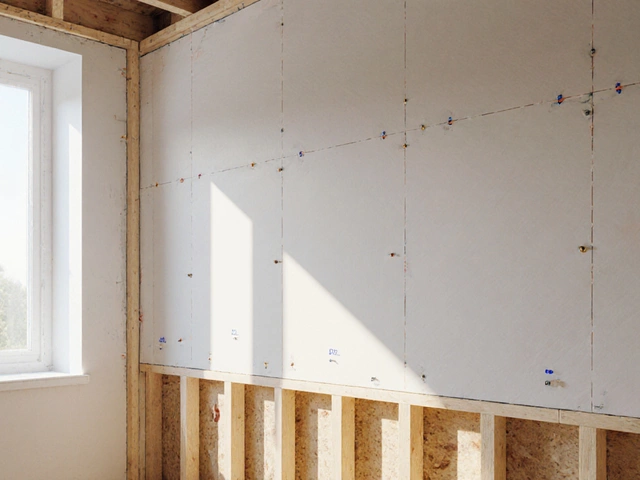Cracks in the foundation of your home are more than just an aesthetic concern—they can signify underlying problems that may lead to serious structural issues if left unaddressed. Understanding the ins and outs of foundation repair is important whether you're a seasoned homeowner or new to the game.
The time it takes to repair a foundation crack can vary widely, depending on several factors. From the type and extent of the damage to the method of repair chosen, each scenario is unique. It's vital to assess the situation correctly, as what might seem like a minor issue could potentially escalate if not treated promptly. In this article, we'll dive into what you need to know to navigate through the process and ensure the stability and safety of your home.
- Understanding Foundation Cracks
- Causes of Foundation Damage
- Assessment and Inspection
- Methods of Repair
- Timeframes and Considerations
Understanding Foundation Cracks
The notion of foundation cracks can easily send shivers down the spine of any homeowner. These cracks are often the first visible signs of potential structural integrity issues. It's crucial to distinguish between cosmetic issues and types of cracks that might indicate a more serious concern requiring foundation repair. Superficial cracks can appear during the natural settling of a house, which is common in new constructions and may not always be alarming. However, significant or widening cracks could be a harbinger of bigger problems, such as shifting soil or improper load distribution, pushing the urgency for professional inspection.
Foundation cracks often stem from unexpected soil movement beneath a home. Expansive clay soils can swell when wet and shrink during drought conditions, leading to shifting that stresses your home's structure. Other soil types can cause similar challenges. Without a doubt, water is a formidable adversary of foundations, and poor drainage or excessive moisture are notorious culprits. Rainwater should be routed away from your home’s perimeter to avoid eroding the soil support or seeping into cracks. It's not just the soil; even material used in foundation construction can sometimes crack due to natural material deterioration or due to external impacts.
Awareness of the common types of foundation cracks is beneficial. Vertical cracks are usually the least concerning, revealing either normal settlement or shrinkage of concrete, while horizontal cracks can indicate serious threats, such as hydrostatic pressure exerted on basement walls. It is essential to have a specialist assess these to determine their cause and significance. "When in doubt, consult an expert," advises Mitch Whittaker, a structural engineer with over two decades of experience.
"Ignoring foundation issues is akin to building your dreams on shaky ground," he asserts, underscoring the importance of professional evaluations.
Repairing these problems promptly is vital. Timely intervention can prevent minor cracks from becoming large fissures that threaten the structural safety of your home. Armed with the right knowledge about house cracks, you can engage in informed discussions with contractors and make decisions suited to protecting your largest investment—your home. Understanding what cannot be ignored versus what can be monitored for future changes empowers homeowners to maintain both the integrity and value of their homes.
Causes of Foundation Damage
The foundation is the backbone of any home, grounding it firmly to withstand various environmental pressures. However, several factors can impact the sturdiness of a foundation, leading to undesirable house cracks. A primary culprit often stems from soil conditions. Certain soils, like expansive clay, swell or shrink dramatically with moisture content. This movement, reminiscent of breathing as the soil contracts and expands, relentlessly tugs at the concrete, which can lead to pressure faults and cracking. If you're domiciled in regions with clay-heavy surroundings, it's not surprising for this soil to become public enemy number one in your foundation saga.
Then there's the issue of poor construction practices. The rush to complete homes sometimes leads builders to cut corners or skip steps, such as not properly compacting the soil before laying the foundation or neglecting to install efficient drainage systems. Over time, inadequate construction can lead to shifting and settling, predisposing the house to structural instability. Speaking of drainage, water — while the essence of life — can be quite the antagonist for concrete. Improperly managed water flow allows rain and ground water to breach the areas around, or even under, the home, eroding soil and jeopardizing the foundation’s integrity.
Climate plays its card too, in this game of threats. Regions that experience severe temperatures, be they torrid heats or biting colds, subject house foundations to a barrage of stress. The continual freezing and thawing cycles, in particular, behave like invisible chisels, slowly prying cracks into the foundation. Natural disasters like earthquakes can produce seismic shocks powerful enough to inflict instant damage or accelerate pre-existing issues. According to a report by the U.S. Geological Survey, “Even minor tremors, such as those that frequently occur in California, change the dynamics exerted upon a home’s structure, leading to unnoticed, yet progressive harm.”
Despite our best efforts, Mother Nature often has the last word when it comes to environmental impacts on our living spaces, says Professor Marcus Hill, a notable geotechnical engineer.
Another factor to consider is the tree roots around your abode. Trees, especially those planted too close, search for nutrients and water, potentially undermining the earth and causing foundation shifting. Meanwhile, insufficient structural design, involving miscalculations in load-bearing aspects or erroneous architectural plans, can also leave a house teetering on poorly-distributed weight points, exacerbating foundation repair needs. At a glance, each listed factor might seem innocuous enough on their own, but they act like a concert of challenges, playing a symphony that you, as a homeowner, may not want to hear. It’s vital to be vigilant about these causes, address any issues promptly, and utilize effective mitigation strategies to keep your foundation standing strong for years to come.

Assessment and Inspection
Before diving into foundation repair, the first step is a thorough assessment and inspection. This critical phase allows you to understand the full scope of the issue and make informed decisions about how to proceed. It's a process that requires patience, diligence, and attention to detail because identifying the root cause of the problem is essential for effective solutions.
Start by visually inspecting both the interior and exterior of your home. Look for signs like cracks in walls, uneven floors, or gaps around windows and doors, which often indicate foundational issues. These visual cues can offer valuable hints about where the troubles lie. If the damage seems mild or you're unsure about its severity, calling in a professional inspector is always wise. Professionals use various tools and methods to assess your home's foundation accurately, such as laser levels, moisture meters, and crack monitors. They can determine if your house has shifted and identify specific areas that need attention.
Engaging Professional Help
Sometimes it is best to call in the experts. A professional inspector can provide insights that might be overlooked by an untrained eye. Among industry favorites is Bob Villa's Home Inspection Checklist, which meticulously covers every angle from soil conditions to drainage issues, ensuring no stone is left unturned during the examination.
"A professional inspection is essential for diagnosing the health of your foundation," says Jim Corello, a renowned structural engineer. "It sets the stage for effective remediation strategies."
An inspector is not only able to point out the severity of the visible cracks and damages but can also employ technology to uncover concealed issues. Techniques like digital imaging and ground penetrating radar enable professionals to see what's happening beneath the surface. The data collected during this phase is critical as it helps decide whether the appropriate repair involves simple epoxy injections or more significant undertakings like underpinning.
Creating a Foundation Report
Once the assessment is complete, a detailed foundation report is usually generated. This document outlines all the findings from the inspection, detailing each crack and area of concern. From this report, a repair plan is devised, which considers not just the observed damage, but also the potential risks if the issues are not addressed. The report is often as detailed as a medical report for your home, providing you a comprehensive overview of its structural health. It includes recommended repair methods, estimated timeframes for completion, and cost approximations. This document serves as a guide to deciding the best course of action for fixing your home’s foundation cracks.
Understanding the assessment and inspection process is key in managing foundation repair efficiently. This stage ensures that you're armed with the knowledge needed to choose appropriate solutions and prevent future occurrences, thus safeguarding your most valuable asset—your home.
Methods of Repair
When it comes to fixing foundation cracks, there are several foundation repair methods available, each suited for different types of damage and circumstances. One of the most common methods is epoxy injections, which are best suited for cracks that do not indicate severe structural issues. Epoxy, a strong, durable resin, is injected into the crack to bind the sections of concrete together. It effectively seals the crack and can restore the load-bearing capacity of the foundation, making it a popular choice for minor non-moving cracks.
For cracks that are not only cosmetic but also indicate movement or settlement issues, underpinning might be necessary. Underpinning involves the installation of piers beneath the foundation to stabilize and lift the sagging areas. There are various underpinning techniques, such as using push piers or helical piers, each with unique installation methods. Push piers are deep foundation strong supports which need to be hydraulically driven through the poor soil and placed solidly beneath the house to ensure stability. Helical piers, on the other hand, resemble a large screw and are often used for lighter structures or when there is limited access. This method is usually employed when there is massive soil movement or significant structural damage.
In cases where water seepage is causing the cracks or worsening their severity, waterproofing solutions such as French drains or sump pumps are often required alongside other repairs. A French drain system helps redirect water away from the foundation, alleviating pressure and preventing future damage. Meanwhile, sump pumps are utilized to remove any accumulated water within the basement area. This approach can both address existing watery conditions and preempt future issues. In fact, a surprising study revealed that nearly 98% of home basements will experience some type of water damage over time, underscoring the importance of such interventions.
"The key to addressing foundation issues lies in determining not just the repair method but understanding the root cause, without which repairs might be futile," suggests Dr. Emily Porter, a renowned structural engineer.
Additionally, carbon fiber stitching is employed on larger horizontal cracks. This method involves adhering carbon fiber strips across the crack during reinforcement, which assists in distributing pressure evenly across weakened sections of the wall. Its lightweight, yet immensely strong nature, makes carbon fiber strips an attractive option for those worried about wall stabilization without the need for intrusive methods.
To efficiently repair house cracks, it's vital to match the repair method with the specific issue at hand. Hiring a certified foundation specialist to assess and recommend the best course of action can save time and costs. It's best to have a customized analysis performed to ensure the integrity and longevity of the repair work undertaken.

Timeframes and Considerations
When it comes to fixing foundation cracks, time is often of the essence, but it's crucial to understand what affects the duration of such repairs. The size and severity of the crack play a significant role; a small hairline fracture might be resolved in just a day with a simple sealant, while more serious damage, such as a large structural crack, could take weeks, especially if underpinning or significant reconstruction is involved. The accessibility of the damaged area also impacts the repair time. A team may quickly address a visible external crack, but if the crack is beneath heavy flooring or walls, additional time and effort may be required to reach it safely.
The type of soil around your home can also influence repair timelines. For instance, clay-heavy soils tend to expand and contract more significantly, potentially causing new cracks even as old ones are fixed. This means monitoring and sometimes waiting for more stable weather conditions is part of the game plan. Additionally, choosing the right method of repair is essential, and each comes with its own time considerations. A simple epoxy injection may solidify within just a few hours, while installing helical piers could demand a longer commitment. The season also plays a critical role; winter might introduce delays due to freezing conditions or limited daylight hours.
Another consideration is how promptly you act after noticing foundation cracks. Procrastination is often the enemy of efficient repairs. The faster you react, the easier it is to prevent minor issues from escalating into more substantial challenges requiring prolonged intervention. It's also wise to consider the experience and availability of your chosen contractors, as less experienced teams may take more time than seasoned professionals. As Bruce Cochrane, a veteran structural engineer, notes, "Responding swiftly and choosing a qualified team are key to managing both risks and costs effectively."
It's also worth looking into the sustainability of your repair choice. Some fixes are temporary, chosen simply as stop-gaps until more permanent solutions can be implemented. This might be cost-effective upfront, but factoring in potential return visits or additional work down the road could alter the timeline, not to mention your budget. Consider opting for more durable solutions whenever possible, which could save you time and headaches in the future. Foundation repair isn't something you can simply ignore or postpone indefinitely. Dealing with it strategically can safeguard your home's integrity for years to come.






